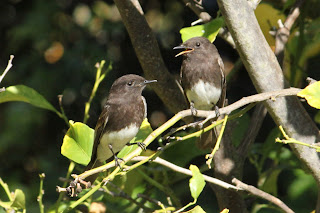 |
| When alarmed, black phoebes raise their crests and produce shrill chirps that become louder, more rapid and frantic sounding. Photo by J.J. Meyer |
When birds talk, we should listen. They may have a very important message about what is happening in our environment.
Birds vocalize for a variety of reasons. In a relaxed state, they use contact calls to check in with a mate or members of the flock, or sing to attract a partner. But in an alarmed state, they can produce a death cry to warn of an approaching predator. These sounds are all different. And studying their behavior is equally important in understanding bird language.
“Birds act as the sentinel species, often sounding the first warning of impending danger,” said Daniel Francis, an instructor and restoration manager at Earthroots Field School.
Francis recently taught a two-hour bird language class as part of a daylong wilderness awareness workshop at the school’s 39-acre site in Big Oak Canyon near the top of Silverado Canyon Road. The nonprofit school, founded by Jodi Levine, seeks to connect people with nature.
“Learning bird language is not like learning a foreign language,” Francis said. It’s much more subtle. It involves recognizing bird vocalizations and reading their behavior for clues to what’s happening in our environment.
“The patterns and nuances of bird behavior are consistent,” he said. “You can watch birds at a backyard feeder in Orange County or go to Brazil and see the same patterns.”
For example, when a hawk flies into an open area where birds are feeding, multiple bird species will shriek an alarm as they ditch into the surrounding thicket. The birds then remain dead silent until the threat is gone.
Other animals are known to heed bird language. A wildlife communication network has evolved as a means of survival. The call of an alarmed junco may cause a deer to lift its head and listen intently. Watching the birds fluttering in an umbrella pattern along the tree canopy then signals to the deer that a predator, such as a coyote, is moving on the ground below. Watching the birds’ movement from tree to tree is a clue to the direction of the coyote’s path.
Francis learned birding skills at an early age from his father, who always kept his binoculars and field guide close at hand. He later trained with bird language experts including Jon Young, author of “What the Robin Knows” (Mariner Books; 2012). Such training requires many hours of observation and quiet field study.
“It’s amazing what we can learn if we’re aware,” Francis said. “But most of us miss it because we’re in our own heads.”
Those who are very attuned to bird language can distinguish between the levels of threat or types of predators. “A mountain lion will make a huge disturbance in the landscape,” he said.
The concept of bird language may sound incredulous. But Francis said he became a believer during a training session when his instructor was able to determine that not only was a predator approaching, but that the songbirds saw it as a significant threat. Students guessed a Cooper’s hawk was on the hunt, but the instructor insisted it had to be larger. That’s when a pair of golden eagles cruised overhead.
For information on future bird language workshops, go to earthrootsfieldschool.org.
No comments:
Post a Comment